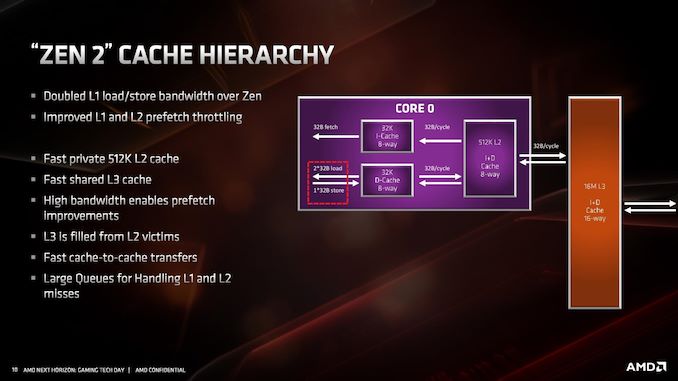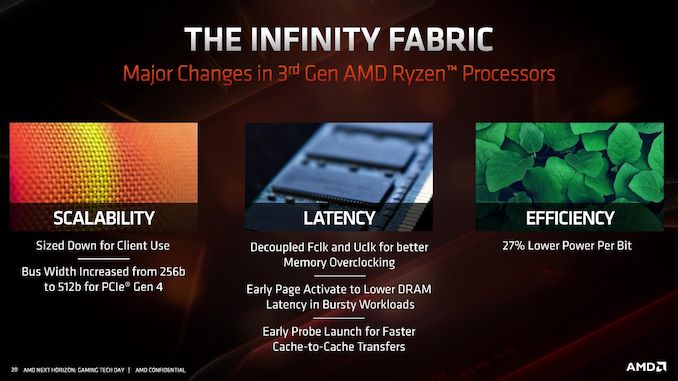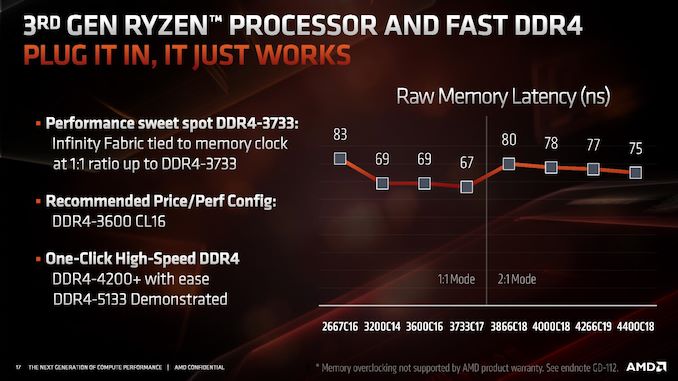AMD Zen 2 Microarchitecture Analysis: Ryzen 3000 and EPYC Rome
by Dr. Ian Cutress on June 10, 2019 7:22 PM EST- Posted in
- CPUs
- AMD
- Ryzen
- EPYC
- Infinity Fabric
- PCIe 4.0
- Zen 2
- Rome
- Ryzen 3000
- Ryzen 3rd Gen
Cache and Infinity Fabric
If it hasn’t been hammered in already, the big change in the cache is the L1 instruction cache which has been reduced from 64 KB to 32 KB, but the associativity has increased from 4-way to 8-way. This change enabled AMD to increase the size of the micro-op cache from 2K entry to 4K entry, and AMD felt that this gave a better performance balance with how modern workloads are evolving.
The L1-D cache is still 32KB 8-way, while the L2 cache is still 512KB 8-way. The L3 cache, which is a non-inclusive cache (compared to the L2 inclusive cache), has now doubled in size to 16 MB per core complex, up from 8 MB. AMD manages its L3 by sharing a 16MB block per CCX, rather than enabling access to any L3 from any core.
Because of the increase in size of the L3, latency has increased slightly. L1 is still 4-cycle, L2 is still 12-cycle, but L3 has increased from ~35 cycle to ~40 cycle (this is a characteristic of larger caches, they end up being slightly slower latency; it’s an interesting trade off to measure). AMD has stated that it has increased the size of the queues handling L1 and L2 misses, although hasn’t elaborated as to how big they now are.
Infinity Fabric
With the move to Zen 2, we also move to the second generation of Infinity Fabric. One of the major updates with IF2 is the support of PCIe 4.0, and thus the increase of the bus width from 256-bit to 512-bit.
Overall efficiency of IF2 has improved 27% according to AMD, leading to a lower power per bit. As we move to more IF links in EPYC, this will become very important as data is transferred from chiplet to IO die.
One of the features of IF2 is that the clock has been decoupled from the main DRAM clock. In Zen and Zen+, the IF frequency was coupled to the DRAM frequency, which led to some interesting scenarios where the memory could go a lot faster but the limitations in the IF meant that they were both limited by the lock-step nature of the clock. For Zen 2, AMD has introduced ratios to the IF2, enabling a 1:1 normal ratio or a 2:1 ratio that reduces the IF2 clock in half.
This ratio should automatically come into play around DDR4-3600 or DDR4-3800, but it does mean that IF2 clock does reduce in half, which has a knock on effect with respect to bandwidth. It should be noted that even if the DRAM frequency is high, having a slower IF frequency will likely limit the raw performance gain from that faster memory. AMD recommends keeping the ratio at a 1:1 around DDR4-3600, and instead optimizing sub-timings at that speed.













216 Comments
View All Comments
GreenReaper - Tuesday, June 11, 2019 - link
A lot of progress has been made. Browsers are far more multithreaded than they once were - and as web pages become more complex, that benefit can scale. Similarly, databases and rendering can scale very well over certain operations.Said scaling tends to work best for the longest operations, because they can be split up into chunks without too much overhead. The overall impact should be that there are fewer long, noticeable delays. There isn't so much progress for things that are already pretty fast - or long sequences of operations that rely on one another. (However, precomputing and prefetching can help.)
stephenbrooks - Thursday, June 13, 2019 - link
I find it surprising how they add these smallish increases onto execution width, out of order buffers, register files etc. The IPC hasn't stopped increasing, it's just slow-ish. Maybe they're fighting power and latency in those part of the core so the 2x density from a node doesn't translate fully.Santoval - Tuesday, June 11, 2019 - link
Prices should drop when the competition with Intel becomes fiercer. I don't expect that anytime soon though.. It doesn't look like Intel will manage to release Ice Lake CPUs (except apparently the -U and -Y ones they announced) this year or at all.Their 10nm+ node is still having serious issues with clocks and thermals, and the yields are much lower than TSMC's 7nm (high performance) node. So "word on the street" is that they won't release Ice Lake CPUs for desktop at all. Id est that they'll can them and release instead Tiger Lake desktop CPUs fabbed with their fixed (??) 10nm++ node variant late next year (as in Q4 2020).
piroroadkill - Wednesday, June 12, 2019 - link
You're wrong. You get more performance than Intel at a lower price. In the case of the 3950X, it's significant. To sell them cheaper would devalue an incredible product, for no reason.Targon - Thursday, June 13, 2019 - link
Ryzen 7 2700X vs. Ryzen 7 3700X. Same price, better performance. Looking at the 3800X which is $399, look at the IPC+clock speed improvements. The 3900X will obviously come at a cost, because you are getting 50% more cores for that increased price. Single threaded though....at what point do you really focus on how fast or slow a single threaded program is running in this day and age where you run dozens of processes at the same time? If you are running dozens of single threaded programs, then performance will change based on how the OS scheduler assigns them to different CPU cores.Qasar - Thursday, June 13, 2019 - link
jjj" They give us around 20% ST gains (IPC+clocks) but at a cost. " that same thing could be said about intels cpus over the last few years... how much performance increase did they give us year over year ?? all while only giving is 4 cores for the mainstream... amd's prices are just fine.. intel is the one that should be dropping their prices, some as low as the $50 you say, but most, $500 or more
Tunnah - Monday, June 10, 2019 - link
I bet now Intel is just going to completely flood ads with the title "Intel beats AMD in pure FPS tests!", because they'll get 210fps where AMD gets 200. And some people will eat it up.I'm so excited for this upgrade. Replacing a 2700K with a 3800X, where I'll not only get a doubling of cores, but clock for clock I reckon it's a 40, 50% improvement there too.
My Civ games are gonna be so zoomy now..
xrror - Monday, June 10, 2019 - link
Intel will always beat AMD ......
...
(at a price point you don't give a f*ck about) (4 digits or more)
Are you a micro-trader hardwired into the BS Stock Exchange? You think $1000+ is too much for the fully enabled processor arch you want to overclock should cost you?
Sorry, Intel doesn't have the time of day for you after 2011, after Sandy Bridge took away the ability to overclock blessed "K" skus...
oh sure, there are others. IDT and Cyrix are dead but... let me introduce you to...
AMD
xrror - Monday, June 10, 2019 - link
This isn't aimed at you Tunnah. I meant it as humor.Read my comment like some exciting infocommercial, with ... (insert commanding infomercial voice here) hehe
Makaveli - Tuesday, June 11, 2019 - link
The 2700k and the 3800X are both 8C 16T designs.